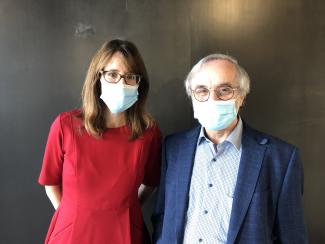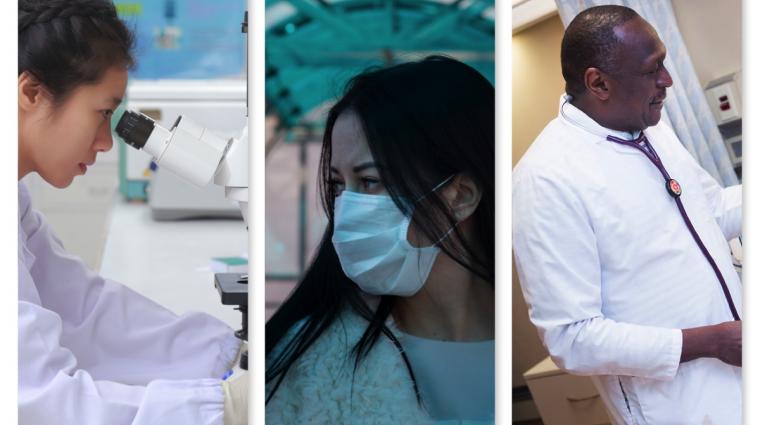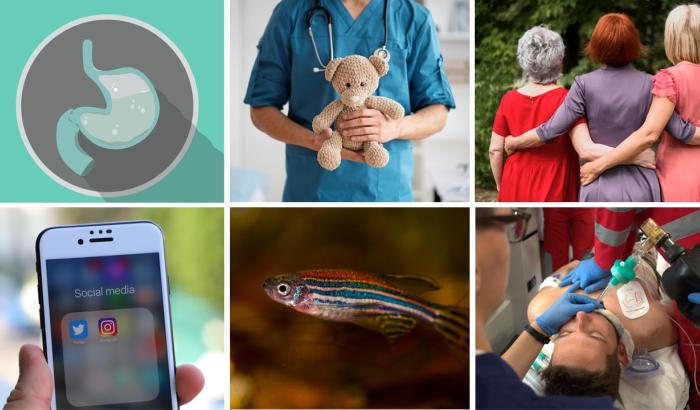
Jean-Paul Bertemes, FNR
Left: Isabel de la Fuente Garcia, pediatrician from the Kannerklinik (Center Hospitalier de Luxembourg). Right: Rudi Balling, director of the LCSB from the University of Luxembourg.
"Are children little angels or little devils?" asks Prof. Rudi Balling, head of the LCSB at the University of Luxembourg. What he means by this: “It is clear that children can become infected with Covid-19. However, they usually show hardly any symptoms. Although they are hardly contagious to adults, they are little angels that infect themselves, but hardly contribute to the spread of the virus in the population. However, if they are highly contagious to adults, they would be little devils, who themselves hardly suffer from the pandemic, but who contribute to the spread of the virus among the population. This has not yet been finally clarified, ”explains Rudi Balling.
Together with the pediatrician Isabel de la Fuenta Garcia, he wrote a policy brief, a fact check on the state of the art that addresses many questions that parents, teachers and the entire population are currently asking themselves - as part of the school openings. First of all: “There is no need to panic about children's health. There are also risk groups among the children that need to be protected. However, it has been shown so far that the majority of children hardly develop any problems with the novel corona virus, ”says Rudi Balling.
About the context: Primary school openings on 25 May
As part of the COVID-19 pandemic, the Luxembourg government closed schools, crèches and daycare centers in Luxembourg on March 16, 2020 - one of many measures to curb the exponential spread of the novel corona virus at that time. After more than 2 months in the lockdown, primary schools, crèches and Maison Relais in Luxembourg will reopen on May 25th. While the lockdown aimed at reducing the number of social contacts in order to slow down the spread of the virus, now thousands of infants and children will have regular and numerous social contacts with their classmates, teachers and caretakers again due to the re-opening of schools. In this context, there are several questions that concern children's health on the one hand and the effects for the entire population on the other hand.
Health of the children
In particular, parents are concerned about the health of their children. The questions arising here are primarily asking how easy children with COVID-19 become infected, whether they develop severe symptoms and whether there are risk groups among the children that need special protection.
According to the latest scientific findings, it can be stated that the novel coronavirus can be particularly dangerous for older people – in contrast to influenza, which more unspecifically is also dangerous for younger people and children with severe illnesses. However, children can clearly become infected with the SARS-CoV-2 virus.
Yet, the course of infection in children is almost always very mild or even asymptomatic. Only in very rare and individual cases, infections can take extreme courses or even lead to death.
Up to now, there are still uncertainties as to how many children are actually infected with the novel corona virus. This is due to different test strategies in the different countries and the lack of biological data. For example, in many countries only people who have clear symptoms are tested. Since children tend to have milder symptoms or none at all, they are often not seen in the statistics. It can therefore be assumed that the number of unreported infected children is high. An estimate based on the officially tested positive children should be viewed carefully and critical for this reason.
There are also risk groups found among children. However, the classic age-related risk factors such as diabetes or high blood pressure do not seem to have a major impact on the course of COVID-19 in children – and only a few children are affected by such diseases at all. It is different with pre-existing conditions such as cancers, kidney diseases or severe impairments of the immune system. Albeit, these diseases are also rare in comparison to the total population. Risk factors that could potentially affect the sensitivity of young patients are still unknown. There is a clear need for research in this aspect to ensure the necessary protection of particularly sensitive people.
Reports of an accumulation of children with Kawasaki syndrome-like disease that could be associated with COVID-19 have received relatively high public attention during the last weeks. This syndrome is a very rare systemic disease. On average, 5 cases per year are reported in Luxembourg and the situation should be closely monitored.
Effects of school openings on the entire population
In addition to questions about children's health, there is also the question of the effects of school openings on the entire population. For this, one particular question is crucial: How infectious are children? How infectious are they for other children, teachers, parents and grandparents? This is an important issue as in the context of easing from the lockdown, it is important to keep the spread of the virus under control. Should children both easily get infected among themselves and also infect adults easily, this could greatly increase the risk of a second wave of infection.
The question of whether children with SARS-CoV-2 are infectious can currently not be answered conclusively. Most studies currently available report a comparably low secondary infection rate in children. Children can generally be infectious, but their transmission rate is probably lower compared to adults. Yet, there is still more research required in this aspect as well.
The current level of knowledge about the sensitivity of preschool children is still very much characterized by uncertainties and knowledge gaps. Many of the studies have been carried out in China, Italy or other countries. However, the specific course of a pandemic, the dynamics or the effects on the course of the disease in patients or the consequences for the health system are often country-specific. Luxembourg has e.g. a very high proportion of immigration with a high level of diversity. This is likely to have a strong impact on the intensity and patterns of social interactions that in turn can have a strong impact on the spread of respiratory infectious diseases.
Reliable data on the prevalence, herd immunity or the dynamics of the COVID-19 pandemic among children in Luxembourg are currently not available. Yet, such data are essential as a basis for political decisions in the field of child health care. The high proportion of asymptomatic children increases the risk of undiscovered SARS-CoV-2 infections in the pediatric environment. For these reasons and in order to be able to take future health policy measures based on knowledge, the implementation of a children's prevalence study could be an option.
Author: Jean-Paul Bertemes, Rudi Balling
Here is the full policy brief from Rudi Balling and Isabel de la Fuenta Garcia
Disclaimer: This report does not make a claim to be exhaustive and is a snapshot on the question of children's exposure to and infection with SARS-CoV-2 and children's sensitivity to COVID-19. Since the scientific knowledge regarding COVID-19 is emerging extremely quickly, many of the studies cited have so far only appeared as preprints (see references) and have not yet gone through the usual peer-review process.
Background
In December 2019, there were reports from Wuhan, China of an above-average accumulation of severe pneumonia, which was classified as Acute Respiratory Stress Disorder (ARSD). In January 2020, the SARS-CoV-2 virus was identified to be responsible for the observed disease called COVID-19. In a period of only 4 months, the originally only locally occurring infectious disease spread worldwide. On March 11, 2020, WHO declared COVID-19 a pandemic. At the end of February, the first patient in Luxembourg was tested positive for COVID-19. As of 8th May 2020, 53,257 SARS-CoV-2 tests had been carried out in Luxembourg, of which 3,871 had a virus-positive result. By the same time, 100 patients had died from the consequences of a COVID-19 infection (www.covid19.lu).
The health consequences of a COVID-19 infection are largely age-dependent. Elderly people are significantly more severely affected and display a higher mortality rate from SARS-CoV-2 infection. Patients over 70 years of age are the most affected, and the average age of those who died from COVID-19 is over 80 years. Evidence- and mechanism-based information about age-dependent specific vulnerability is particularly important in the context of public health care measures. In addition to the special protection of the older population, this also includes possible measures for other population groups, such as of children and infants. For children, the situation regarding the consequences of COVID-19 infection is rather the opposite than for elderly people: Only a minority develops severe COVID-19 symptoms. However, in rare individual cases, children and infants can develop severe forms and even die as a result of the infection. So far, two children with SARS-CoV-2 infection had to be treated in intensive care in Luxembourg. Up to now, no child has died though and both affected children are on the mend.
In the context of the COVID-19 pandemic, among others the question arose whether specific aspects of the COVID-19 infection such as transmission or vulnerability of children would have to be considered, e.g. when opening and closing or operating kindergartens and other preschool facilities (creches, childminders). This report briefly presents the current state of science on the following questions:
What is the risk of a SARS-CoV-2 infection in children compared to adults and elderly people?
One of the most striking features of the current COVID-19 pandemic is the very high susceptibility of elderly people. The average age of patients dying from SARS-CoV-2 infection is over 80 years. As can be seen from Fig. 1B, the relative risk drastically increases with age. At the same time, the data currently available show that children are practically unaffected by the consequences of this infectious disease. The low proportion of children who develop COVID-19 has been observed worldwide and has been documented in various studies during the recent weeks and months. The number of confirmed positive cases is highest especially in the age groups between 20 and 60 years, while there are hardly any patients found below 15 years of age.
1A: Age distribution of COVID-19 patients from China: The light blue bars show the total number of 507 patients in the different age groups. The dark blue bars show the proportion of patients who died. The dashed blue line shows the median age of the surviving and deceased patients.
1B: Relative risk of COVID-19 patients: The green bars show the total number of 364 patients; the dark green dots indicate the relative risk and the dark green dashed line shows the smoothed average risk depending on age.
(Sun, K. et. al. , Lancet Digital Health, (Sun et al., 2020)
This unequal distribution becomes even more clear when looking at the risk of death depending on age. The majority of deaths are attributable to patients older than 70 years (Fig. 2). The risk of death is extremely low for children under the age of 10.
There are several hypotheses that could account for the lower death rate in children. One factor is the relative proportion of younger people in a society like Luxembourg. The high mortality rate in Italy, for example, was partly explained by the fact that the proportion of elderly people in Italy is higher than in other western and, in particular, Asian and African countries (Dowd et al., 2020). An important factor for SARS-CoV-2 infection in the general population appears to be the number and type of social contacts and interactions within the social networks. The intensity and pattern of social contacts are age-dependent (Mossong et al., 2008; Zhang et al., 2020). However, 10 to 14-year-old children do not have less but rather more social contacts, so their number is probably not the reason for the low susceptibility of children towards SARS-CoV-2.
Another hypothesis for a lower infection rate in children is a generally lower sensitivity to SARS-CoV-2 infection. The reasons for this observation are currently not known. A lower expression of the ACE2 receptor for virus uptake, greater immunity in children or other metabolic processes that support a lower infection rate or a better defense against infection are currently under discussion (Santesmasses et al., 2020).
However, it should be noted that especially in the early phase of the COVID-19 pandemic almost exclusively people with clinical symptoms were tested. However, the clinical course in children is usually very mild and unspecific and only in very rare cases leads to severe symptoms (Davies et al., 2020). In children under the age of 10, clinical symptoms were diagnosed in only 20% of the cases, while the majority of infections proceeded subclinical or even asymptomatic. As children show no symptoms in the majority of cases, the likelihood that an existing SARS-CoV-2 infection is not discovered is relatively high. There also seems to be a relatively large proportion of infected, positively tested, but yet asymptomatic adults (Lavezzo et al., 2020). This means that infections remain undetected and the real infection rate is underestimated. The assumed number of unreported cases is estimated at a factor of 5-10 and is probably even higher in children than in adults due to the mild symptoms.
One of the most extensive COVID-19 studies in children is a study conducted by Dong et al. (2020). In a retrospective study, the authors examined 728 confirmed and 1407 suspected cases of COVID-19 patients under the age of 18 across China. SARS-CoV-2 positive children were identified in all age groups, the percentage of severely affected children ranged between 3 and 10.3%. The authors conclude that children are principally sensitive to infection with SARS-CoV-2 and that children under one year of age had the greater proportion of severe forms. However, it is unclear whether these severe forms were really caused by a SARS-CoV-2 infection or whether respiratory syncytial virus (RSV), human meta-pneumo virus (hPMV) or other respiratory infections are partly responsible for it.
An investigation of 149,760 confirmed COVID-19 cases in the USA (CDC 2020) showed an infection rate of 1.7%. The hospitalization rate was only half that of adults (5.7% vs. 10% in 18-64 year olds). Bi et al. (Bi et al., 2020) report from Shenzen (China) an approximately similar proportion of infected children between the ages of 0-10 years. A comparison of children and adults under the age of 10 years showed no difference in the SARS-CoV-2 transmission rate, but the symptoms in children were also generally lower than in the rest of the population.
In a study from pediatric children's hospitals in Italy by Parrie, N. and Lenge, M. (2020), 1% of all COVID-19 patients were younger than 18 years. Out of these, 11% were hospitalized whereas none of the children died.
In a study in Iceland (Gudbjartsson et al., 2020), the infection status of both selected children and adults with high and normal risk of infection was examined. Out of 564 children under the age of 10, 6.7% were infected with SARS-CoV-2. The proportion of SARS-CoV-2-positive in over 10-year-olds was 13.7% while in a random population sample it was found to be only 0.8%. Out of 848 children under the age of 10, none were virus-positive, while 100 of 12,232 people over the age of 10 were diagnosed with SARS-CoV-2. It is important to note that, unlike in Luxembourg and many other countries, pre-primary and primary schools have not been closed in Iceland. The National Institute for Public Health and the Environment in the Netherlands also reports that children are less likely to become infected with SARS-CoV-2 and that patients under the age of 20 have a lower role in the spread of SARS-CoV-2 infections compared to adults. The authors conclude that SARS-CoV-2 transmission takes place primarily between people of the same age group. However, the data is not yet available as a publication, but only on the institute's website.
These data show that although children can be infected with SARS-CoV-2, the infection rate and, above all, the clinical symptoms are considerably lower than in adults. It is currently still unknown whether the reason for this difference is a lower virus exposure of the younger children or an increased resistance to SARS-CoV-2 infection.
Summary: Children can undoubtedly become infected with the SARS-CoV-2 virus. The infection rate of children is currently still uncertain due to different test strategies in the different countries and due to the lack of biological data, and an assessment based on those officially tested as positive should be viewed carefully and critically. The course of infection in children is almost always very mild or even asymptomatic. Severe courses are observed only in very rare cases.
Are children infectious themselves during an infection with SARS-CoV-2?
Information about the risk of infection from children would be extremely important information when assessing public preventive measures, especially those relating to schools, kindergartens and other preschool institutions. It is not currently clear whether and to what extent children can infect other children or adults themselves.
The most important route of transmission of SARS-CoV-2 in the population is probably a droplet infection due to coughing, sneezing or breathing in virus-bearing aerosols, especially in closed rooms. In addition, contact transmission through contaminated surfaces is also assumed to play a role. A transmission from mother to child during childbirth or through breast milk cannot be excluded at the present time. Diseases of newborn children have been described in isolated cases.
The determination of the infection with SARS-CoV-2 by children can be achieved by tracing the infection chains that emerge from children. The direct determination of the virus concentration in the throat or saliva of children can provide an indirect indication of the potential infectivity. Jones, TC et al. (Jones et al., 2020) have determined virus titers in 3,712 COVID-19 patients. In their work, they conclude that the virus concentrations in children are approximately the same as in older people and that there is no reason to assume that children are not infectious (Fig. 3). Based on these results, they urge caution against unlimited opening of kindergartens in the current situation. However, it is unclear whether the level of the measured virus concentrations is actually correlated with the height of a transmission risk.
The National Center for Immunization Research and Surveillance (NCIRS) in Australia comes to another assessment. There, the contacts of SARS-CoV-2 infected in 15 schools were followed up to see if infected students could infect other students or teachers2. Despite the presence of 9 infected pupils and 9 infected teachers or school employees, only 2 secondary infections were identified in 863 closer contacts. No case was found in which teachers were infected by students. The NCIRS concludes from this that the transmission of SARS-CoV-2 between children and from children to adults is low and is not the primary driving force in schools or in the population. This study has not yet been published in a scientific journal, but the results are only listed on the research center's website.
The National Institute for Public Health and the Environment in the Netherlands came to a similar conclusion as the Australian study (Fig. 4). According to this study, children rarely pass on an infection. Similar to the Australian study, these data have not yet been published.
The study conducted by Gudbjartsson, D.F. et al. (2020) in Iceland comes to the conclusion that although children can be infected with SARS-CoV-2 in principle, the infection rate in children is lower compared to adults. While almost all of the empirical data indicate that children do not play a major role in SARS-CoV-2 transmission, the reasons for this difference are not yet known. A lower exposure of the younger children, a different intensity or different patterns of social contact or an increased resistance to a COVID-19 infection could be a potential explanation.
An extreme example of a possibly lower SARS-CoV-2 transmission rate of children at school is the case of an infected child in an infection cluster in the French Alps (Les Cotamines) (Danis et al., 2020). Despite intensive contacts with a large number of social contacts in 3 different schools, there was no transmission of SARS-CoV-2 among 172 identified contacts. The observation that in contrast other respiratory viruses (Influenza A and Picorna viruses) which were regularly transmitted between the pupils suggests a lower infection among children with SARS-CoV-2.
An investigation in the Italian city of Vo (Lavezzo et al., 2020) also concluded that children have a low risk of infection from SARS-CoV-2 infection. Infection was not detected in 234 tested children aged 0-10 years, although some of the children lived in households with infected people. In contrast, the prevalence rate in the 10 to 50-year-old people rose to 1.2-1.7% and older individuals showed a 3-fold increase in the rate.
In contrast, in the widely discussed “Gangelt / Heinsberg” study (Streeck et al., n.d.) no influence of age on the infection rate was observed. However, the study included children under the age of 18 but none under the age of 5.
Summary: Most studies, such as those from Australia, the Netherlands or Iceland report a rather lower secondary infection rate in children. Children can generally be infectious, but the transmission rate is very likely to be lower in comparison to adults.
Are there symptoms or risk factors found in children that could indicate a particular sensitivity to a SARS-CoV-2 infection?
As shown above, children are significantly less affected by SARS-CoV-2 infections than older people compared to other age groups (Dong et al., 2020; Sun et al., 2020). The symptoms are usually very mild and in 35-80 % of cases the infection is even asymptomatic. Infected children, on the other hand, show a greater variety of symptoms. In addition to the classic symptoms such as fever, cough and sore throat, gastrointestinal, dermatological and neurological symptoms are also observed (MMWR CDC 2020).
A large proportion of the elderly COVID-19 patients possess comorbidities such as diabetes, obesity, high blood pressure and previous cardiovascular diseases. There is currently no convincing data that these typical age-related risk factors also lead to a manifestation or a more severe course of COVID-19 in children. The situation is different with existing medical conditions such as cancers, kidney diseases or severe impairments of the immune system (Lu et al., 2020). However, these are also rare in comparison to the total population. Risk factors that could potentially affect the sensitivity of young patients are still unknown. There is a clear need for research here to ensure the necessary protection of particularly sensitive people.
Reports of an accumulation of children with Kawasaki syndrome-related illness that may be associated with COVID-19 have received a relatively high level of public awareness in the last weeks. This is a very rare systemic disease with around 9 out of 100,000 affected children under the age of five, which is often accompanied with viral infections, especially influenza, and is associated with symptoms such as fever, inflammation of the vascular system or skin rashes. The Kawasaki syndrome can usually be treated well with medication (Riphagen et al., 2020). There are an average of 5 cases per year in Luxembourg and the situation should be closely monitored.
It is important that in times of a pandemic, increased attention is paid to the involvement of rare genetic or environmental factors that increase infectious diseases such as COVID-19. This also includes co-infections with other pathogens such as viruses, bacteria or parasites. The National Institute of Health (NIH) in the United States, led by Jean-Laurent Casanova, has started a large-scale study (COVID Human Genetic Effort) to determine the involvement of rare congenital immune disorders associated with a very severe course of otherwise healthy children and under 50-year-old adults.
https://www.niaid.nih.gov/research/host-genetics-severe-COVID-19-infection
https://www.rockefeller.edu/our-scientists/heads-of-laboratories/970-jean-laurent-casanova/
The National Institute of Allergy and Infectious Diseases (NIAID), also at the NIH, is currently preparing a large-scale study to examine the rate of new SARS-CoV-2 infections especially in children (HEROS-Human Epidemiology and Response to SARS-CoV -2). The aim is to test 6,000 children from 2,000 families for the presence of the virus using PCR and for SARS-CoV-2 antibodies. One focus will be the question of whether asthma or other allergic diseases affect COVID-19 symptoms, since there are indications that COVID-19 patients with asthmatic diseases are more likely to be protected against COVID-19 (Halpin et al., 2020).
Summary: In the vast majority of cases, SARS-CoV-2 infections in children develop with no or only very mild symptoms. Only in very rare individual cases, severe or lethal courses are observed. Genetic factors that increase the course of COVID-19 are not yet known. The classic age-related risk factors such as diabetes or high blood pressure do not seem to have a major impact on the course of COVID-19. Children with serious previous illnesses such as e.g. leukaemia, kidney problems or other organ diseases are at highest risk.
The situation in Luxembourg
In Luxembourg, up to May 8, 2020, 3,871 were positively identified with SARS-CoV-2 out of 53,257 people tested. So far, 100 people have died of COVID-19. Similar to other countries, children younger than 10 years (Fig. 5) are hardly affected. Only 0.24% of those who tested positive were younger than 5 years, although this age group makes up 4.55% of the population.
Experiences with children in the Luxembourg Kannerklinik (unpublished data)
On average, 6,500 patients <15 years old are admitted every year. A positive result was found in 9 out of 123 children between the ages of 0 and 15 years who were admitted to the Kannerklinik of the Center Hospitalier de Luxembourg and tested by PCR for SARS-CoV2 infection. In addition, another child with positive SARS-CoV2 serology was diagnosed with a critical condition likely caused by COVID-19. The majority of cases (n: 9) were diagnosed between March 17 and April 15. The age of infected children is between 7 weeks and 11 years (average age 3.9 years). The hospitalization of adolescents and children under the age of 18 accounted for 1% of all hospital patients during this period (9 PCR-positive cases / 967 hospitalizations).
Out of these children, 4 (40 %) (mean age 8 months) had low to mild symptoms (hospitalization due to neurological comorbidity in 2 of them) and 6 (60 %) showed more serious illnesses. Two children (20 % of the total; 8 and 11 years) were admitted to the intensive care unit due to heart failure (myocarditis and atypical Kawasaki syndrome) but did not require invasive ventilation and were discharged home after a week in hospital with excellent development of the infection. Overall, no increased hospitalization rate was observed in the Kannerklinik during the past two months and no hospital-acquired (nosocomial) SARS-CoV2 infection was identified. The situation at the Kannerklinik in Luxembourg is therefore comparable to the observations in other countries. SARS-CoV-2-infected children only develop critical forms of the disease in rare cases.
The data described here have recently been accepted for publication in the Pediatric Infectious Disease Journal: Marie-Laure Oberweis, Andrei Codreanu, Wolfgang Böhm, Damien Olivier, Charlotte Pierron, Chantal Tsobo, Michel Kohnen, Tamir T. Abdelrahman, Nguyen T. Nguyen, Kerstin Wagner, Isabel de la Fuente. Pediatric life-threatening COVID 19 with myocarditis.
Possible clarification of open questions through a Luxembourg prevalence study for children
As outlined in this paper, there are a number of open questions and knowledge gaps in the areas of prevalence, risk of infection, and sensitivity of children associated with COVID-19. One of the open questions is why children after SARS-CoV-2 infection develop no or only very mild symptoms. An understanding of the underlying mechanisms could provide clues to possible prevention or therapy approaches. The question why infected children are empirically less likely to be contagious has also not been answered. Biological mechanisms or the type or pattern of social interactions that are relevant for virus transmission are currently under discussion. The investigation of rare diseases in children that adversely affects the severity of COVID-19 also has a great potential.
Reliable data on the prevalence, herd immunity or the dynamics of the COVID-19 pandemic in Luxembourg are currently not available. Many of the studies have been carried out in China, Italy or other countries. However, the specific course of a pandemic, the dynamics or the effects on the course of the disease in patients or the consequences for the health system are mostly country-specific. Luxembourg has e.g. a very high proportion of immigrants with a high ethnic diversity. A special feature in Luxembourg are also the cross-border commuters, whose children are only partially cared for in Luxembourg preschool institutions.
Reliable country-specific data on the causal drivers of COVID-19 are also essential as a basis for political decisions in the field of child health care. As part of the Research Luxembourg COVID-19 Task Force, the prevalence study "CON-VINCE" was initiated in April 2020. In addition to short-term information on the current status of the SARS-CoV-2 infection rate, this study also provides valuable insights into the above-mentioned open questions. The study will also provide important information for an appropriate vaccination strategy for COVID-19.
Unfortunately, for various reasons, only people over the age of 18 and no children could be recruited in this study. This means that reliable data on prevalence and herd immunity in children are lacking, and in the long term both clinical and epidemiological data are missing. Due to the high proportion of asymptomatic children, the risk of undiscovered SARS-CoV-2 infections in the pediatric environment increases. For these reasons and in order to be able to take future health policy measures based on knowledge, the implementation of a children's prevalence study is encouraged. The know-how required for this is available in Luxembourg.
Autor: Rudi Balling, Isabel de la Fuente Garcia
Editor: Jean-Paul Bertemes (FNR)
Infobox
Bi, Q., Wu, Y., Mei, S., Ye, C., Zou, X., Zhang, Z., Liu, X., Wei, L., Truelove, S. A., Zhang, T., Gao, W., Cheng, C., Tang, X., Wu, X., Wu, Y., Sun, B., Huang, S., Sun, Y., Zhang, J., … Feng, T. (2020). Epidemiology and transmission of COVID-19 in 391 cases and 1286 of their close contacts in Shenzhen, China: a retrospective cohort study. The Lancet Infectious Diseases, 3099(20), 1–9. https://doi.org/10.1016/S1473-3099(20)30287-5
Danis, K., Epaulard, O., Benet, T., Gaymard, A., Campoy, S., Bothelo-Nevers, Elisabeth Bouscambert-Duchamp, Maude Spaccaferri, G., Ader, F., Mailles, A., Boudalaa, Z., Tlsma, V., Berra, J., & Vau, C. (2020). Cluster of coronavirus disease 2019 (Covid-19) in the French Alps, 2020. Clinical Infectious Diseases : An Official Publication of the Infectious Diseases Society of America. https://doi.org/10.1093/cid/ciaa424
Davies, N. G., Klepac, P., Liu, Y., Prem, K., Jit, M., & Eggo, R. M. (2020). Age-dependent effects in the transmission and control of COVID-19 epidemics. MedRxiv, 2020.03.24.20043018. https://doi.org/10.1101/2020.03.24.20043018
Dong, Y., Mo, X., Hu, Y., Qi, X., Jiang, F., Jiang, Z., & Tong, S. (2020). Epidemiology of COVID-19 Among Children in China. Pediatrics, 145(6), e20200702. https://doi.org/10.1542/peds.2020-0702
Dowd, J. B., Andriano, L., Brazel, D. M., Rotondi, V., Block, P., Ding, X., Liu, Y., & Mills, M. C. (2020). Demographic science aids in understanding the spread and fatality rates of COVID-19. Proceedings of the National Academy of Sciences, 202004911. https://doi.org/10.1073/pnas.2004911117
Gudbjartsson, D. F., Helgason, A., Jonsson, H., Magnusson, O. T., Melsted, P., Norddahl, G. L., Saemundsdottir, J., Sigurdsson, A., Sulem, P., Agustsdottir, A. B., Eiriksdottir, B., Fridriksdottir, R., Gardarsdottir, E. E., Georgsson, G., Gretarsdottir, O. S., Gudmundsson, K. R., Gunnarsdottir, T. R., Gylfason, A., Holm, H., … Stefansson, K. (2020). Spread of SARS-CoV-2 in the Icelandic Population. New England Journal of Medicine, 1–14. https://doi.org/10.1056/nejmoa2006100
Halpin, D. M. G., Faner, R., Sibila, O., Badia, J. R., & Agusti, A. (2020). Do chronic respiratory diseases or their treatment affect the risk of SARS-CoV-2 infection? The Lancet Respiratory Medicine, 8(May), 436–438. https://doi.org/10.1016/S2213-2600(20)30167-3
Jones, T. C., Mühlemann, B., Veith, T., Zuchowski, M., Hofmann, J., Stein, A., Edelmann, A., Max Corman, V., Drosten, C., & Christian Drosten, P. (2020). An analysis of SARS-CoV-2 viral load by patient age. https://zoonosen.charite.de/fileadmin/user_upload/microsites/m_cc05/virologie-ccm/dateien_upload/Weitere_Dateien/analysis-of-SARS-CoV-2-viral-load-by-patient-age.pdf
Lavezzo, E., Franchin, E., Ciavarella, C., Cuomo-Dannenburg, G., Barzon, L., Vecchio, C. Del, Rossi, L., Manganelli, R., Loregian, A., Navarin, N., Abate, D., Sciro, M., Merigliano, S., Decanale, E., Vanuzzo, M. C., Saluzzo, F., Onelia, F., Pacenti, M., Parisi, S., … Crisanti, A. (2020). Suppression of COVID-19 outbreak in the municipality of Vo, Italy. MedRxiv, Ci, 2020.04.17.20053157. https://doi.org/10.1101/2020.04.17.20053157
Lu, X., Zhang, L., Du, H., & Jingjing Zhang 2 , Yuan Y Li 2 , Jingyu Qu 2 , Wenxin Zhang 2 , Youjie Wang 2 , Shuangshuang Bao 2 , Ying Li 2 , Chuansha Wu 2 , Hongxiu Liu 2 , Di Liu 3 , Jianbo Shao 2 , Xuehua Peng 2 , Yonghong Yang 4 , Zhish, C. P. N. C. S. T. (2020). SARS-CoV-2 Infection in children. The New England Journal of Medicine, 4–6. https://doi.org/10.1056/NEJMc1210001
Mossong, J., Hens, N., Jit, M., Beutels, P., Auranen, K., Mikolajczyk, R., Massari, M., Salmaso, S., Tomba, G. S., Wallinga, J., Heijne, J., Sadkowska-Todys, M., Rosinska, M., & Edmunds, W. J. (2008). Social contacts and mixing patterns relevant to the spread of infectious diseases. PLoS Medicine, 5(3), 0381–0391. https://doi.org/10.1371/journal.pmed.0050074
Riphagen, S., Gomez, X., Gonzalez-Martinez, C., Wilkinson, N., & Theocharis, P. (2020). Correspondence Hyperinflammatory shock in children during COVID-19 pandemic. The Lancet, 6736(20). https://doi.org/https://doi.org/10.1016/S0140-6736(20)31094-1
Santesmasses, D., Castro, J. P., Zenin, A. A., Shindyapina, A. V, Gerashchenko, M. V, Zhang, B., Kerepesi, C., Yim, S. H., Fedichev, P. O., & Gladyshev, V. N. (2020). COVID-19 is an emergent disease of aging. MedRxiv, 2019, 2020.04.15.20060095. https://doi.org/10.1101/2020.04.15.20060095
Streeck, H., Schulte, B., Kümmerer, B. M., Richter, E., Höller, T., Fuhrmann, C., Bartok, E., Dolscheid, R., Berger, M., Wessendorf, L., Eschbach-bludau, M., Kellings, A., Schwaiger, A., Coenen, M., Schmithausen, R. M., Schmid, M., & Hartmann, G. (n.d.). Infection fatality rate of SARS-CoV-2 infection in a German community with a super-spreading event.
Sun, Y., Koh, V., Marimuthu, K., Ng, O. T., Young, B., Vasoo, S., Chan, M., Lee, V. J. M., De, P. P., Barkham, T., Lin, R. T. P., Cook, A. R., & Leo, Y. S. (2020). Epidemiological and Clinical Predictors of COVID-19. Clinical Infectious Diseases : An Official Publication of the Infectious Diseases Society of America, Xx Xxxx, 1–7. https://doi.org/10.1093/cid/ciaa322
Wu, Z., & McGoogan, J. M. (2020). Characteristics of and Important Lessons from the Coronavirus Disease 2019 (COVID-19) Outbreak in China: Summary of a Report of 72314 Cases from the Chinese Center for Disease Control and Prevention. JAMA - Journal of the American Medical Association, 323(13), 1239–1242. https://doi.org/10.1001/jama.2020.2648
Zhang, J., Litvinova, M., Liang, Y., Wang, Y., Wang, W., Zhao, S., Wu, Q., Merler, S., Viboud, C., Vespignani, A., Ajelli, M., & Yu, H. (2020). Changes in contact patterns shape the dynamics of the COVID-19 outbreak in China. Science, 8001(April), eabb8001. https://doi.org/10.1126/science.abb8001







